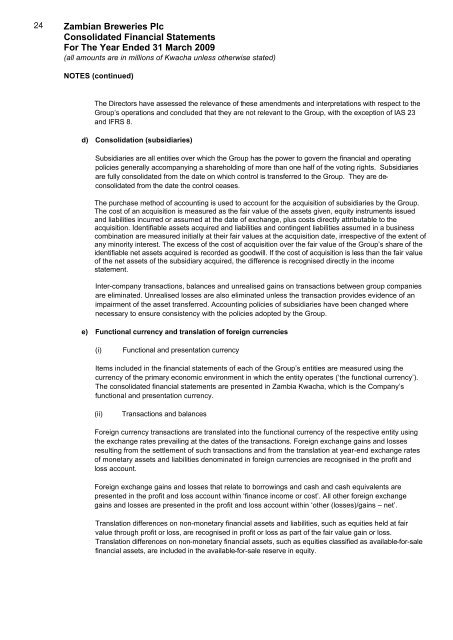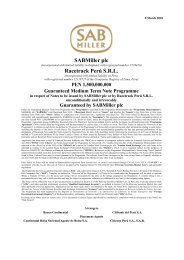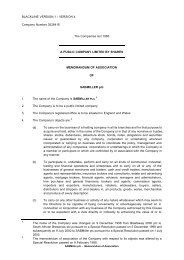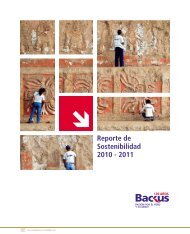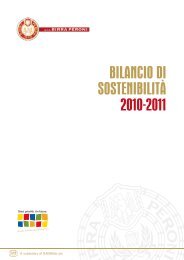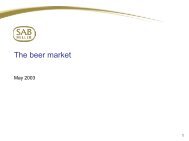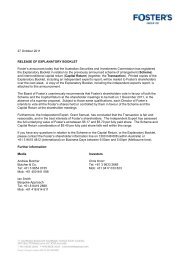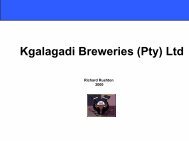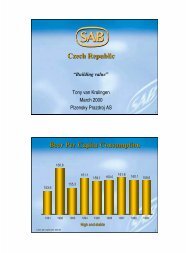Download the Zambian Breweries 2009 Annual report ... - SABMiller
Download the Zambian Breweries 2009 Annual report ... - SABMiller
Download the Zambian Breweries 2009 Annual report ... - SABMiller
You also want an ePaper? Increase the reach of your titles
YUMPU automatically turns print PDFs into web optimized ePapers that Google loves.
24 <strong>Zambian</strong> <strong>Breweries</strong> Plc<br />
Consolidated Financial Statements<br />
For The Year Ended 31 March <strong>2009</strong><br />
(all amounts are in millions of Kwacha unless o<strong>the</strong>rwise stated)<br />
NOTES (continued)<br />
The Directors have assessed <strong>the</strong> relevance of <strong>the</strong>se amendments and interpretations with respect to <strong>the</strong><br />
Group’s operations and concluded that <strong>the</strong>y are not relevant to <strong>the</strong> Group, with <strong>the</strong> exception of IAS 23<br />
and IFRS 8.<br />
d) Consolidation (subsidiaries)<br />
Subsidiaries are all entities over which <strong>the</strong> Group has <strong>the</strong> power to govern <strong>the</strong> financial and operating<br />
policies generally accompanying a shareholding of more than one half of <strong>the</strong> voting rights. Subsidiaries<br />
are fully consolidated from <strong>the</strong> date on which control is transferred to <strong>the</strong> Group. They are deconsolidated<br />
from <strong>the</strong> date <strong>the</strong> control ceases.<br />
The purchase method of accounting is used to account for <strong>the</strong> acquisition of subsidiaries by <strong>the</strong> Group.<br />
The cost of an acquisition is measured as <strong>the</strong> fair value of <strong>the</strong> assets given, equity instruments issued<br />
and liabilities incurred or assumed at <strong>the</strong> date of exchange, plus costs directly attributable to <strong>the</strong><br />
acquisition. Identifiable assets acquired and liabilities and contingent liabilities assumed in a business<br />
combination are measured initially at <strong>the</strong>ir fair values at <strong>the</strong> acquisition date, irrespective of <strong>the</strong> extent of<br />
any minority interest. The excess of <strong>the</strong> cost of acquisition over <strong>the</strong> fair value of <strong>the</strong> Group’s share of <strong>the</strong><br />
identifiable net assets acquired is recorded as goodwill. If <strong>the</strong> cost of acquisition is less than <strong>the</strong> fair value<br />
of <strong>the</strong> net assets of <strong>the</strong> subsidiary acquired, <strong>the</strong> difference is recognised directly in <strong>the</strong> income<br />
statement.<br />
Inter-company transactions, balances and unrealised gains on transactions between group companies<br />
are eliminated. Unrealised losses are also eliminated unless <strong>the</strong> transaction provides evidence of an<br />
impairment of <strong>the</strong> asset transferred. Accounting policies of subsidiaries have been changed where<br />
necessary to ensure consistency with <strong>the</strong> policies adopted by <strong>the</strong> Group.<br />
e) Functional currency and translation of foreign currencies<br />
(i)<br />
Functional and presentation currency<br />
Items included in <strong>the</strong> financial statements of each of <strong>the</strong> Group’s entities are measured using <strong>the</strong><br />
currency of <strong>the</strong> primary economic environment in which <strong>the</strong> entity operates (‘<strong>the</strong> functional currency’).<br />
The consolidated financial statements are presented in Zambia Kwacha, which is <strong>the</strong> Company’s<br />
functional and presentation currency.<br />
(ii)<br />
Transactions and balances<br />
Foreign currency transactions are translated into <strong>the</strong> functional currency of <strong>the</strong> respective entity using<br />
<strong>the</strong> exchange rates prevailing at <strong>the</strong> dates of <strong>the</strong> transactions. Foreign exchange gains and losses<br />
resulting from <strong>the</strong> settlement of such transactions and from <strong>the</strong> translation at year-end exchange rates<br />
of monetary assets and liabilities denominated in foreign currencies are recognised in <strong>the</strong> profit and<br />
loss account.<br />
Foreign exchange gains and losses that relate to borrowings and cash and cash equivalents are<br />
presented in <strong>the</strong> profit and loss account within ‘finance income or cost’. All o<strong>the</strong>r foreign exchange<br />
gains and losses are presented in <strong>the</strong> profit and loss account within ‘o<strong>the</strong>r (losses)/gains – net’.<br />
Translation differences on non-monetary financial assets and liabilities, such as equities held at fair<br />
value through profit or loss, are recognised in profit or loss as part of <strong>the</strong> fair value gain or loss.<br />
Translation differences on non-monetary financial assets, such as equities classified as available-for-sale<br />
financial assets, are included in <strong>the</strong> available-for-sale reserve in equity.


